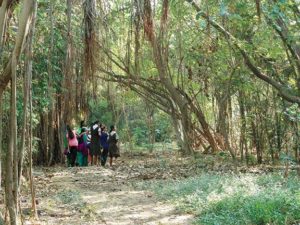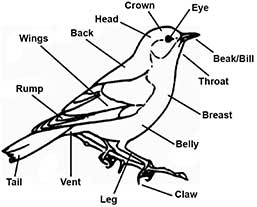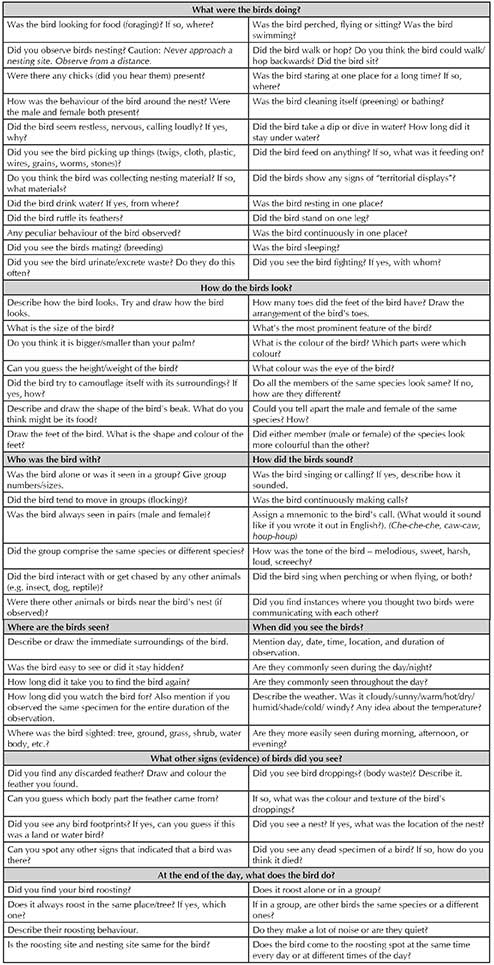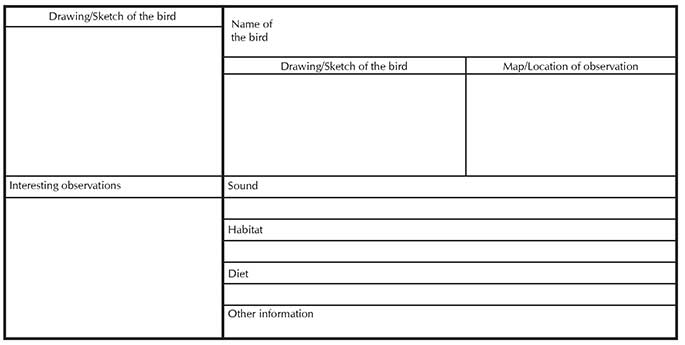Adithi Muralidhar
This is the third article of a four-part series on a simple learning unit on observing birds, developed as part of the Vigyan Pratibha Project. The learning unit is constantly updated based on feedback received from students and teachers. For updated information on this unit, visit https://vp.hbcse.tifr.res.in/
Student Handout #1

Basics and ethics of bird watching
- Keep your distance from the bird when you observe them.
- Never approach a bird so closely as to disturb it or make it fly away.
- Do not harm the natural surroundings just to observe the bird better. For e.g. stamping over plants, trampling on fragile habitats, breaking twigs/branches to get an unobstructed view of the bird.
- Do not encroach (trespass) into private property while bird watching. Always obtain permission from the land-owner before entering private lands.
- Do not be noisy.
- Do not feed the birds or play the calls of birds to bring them closer to you.
- Do not approach any nesting area/nest. Never handle eggs. Observe from a distance.
- Be extra careful about observing birds during the breeding season.
- If you think the bird is disturbed by your presence and it keeps flying away, then do not follow it.
- Moving around doesn’t necessarily mean you will see more birds. If you stand/sit in one place quietly and patiently, staying absolutely still, you can see many birds.
- If possible, wear dull coloured clothes while bird watching. Avoid strong smelling powders, creams, perfumes, lotions, etc.
- If you intend to click photographs of birds, then ensure you do not use flash especially if you are near nesting area/sites.
Remember, bird watchers must always act in ways that do not endanger the birds and their surroundings.
Knowing terminology related to bird behaviour
Here are some of the behaviours that you may observe:
- Feeding: eating food or drinking water
- Flocking: birds grouping together, either during flying or while looking for food
- Flying: the act of staying in the air by flapping wings or soaring
- Foraging: the act of looking around for food
- Mating: the action of birds coming together to breed
- Nesting: the act of building a nest, which is a structure to hold the eggs and chicks
- Preening/Bathing: the act of cleaning oneself or another
- Roosting: a behaviour where birds settle in groups (or alone), at a particular area to rest/sleep
- Singing or Calling: communication between birds
- Territorial display: the act of protecting a tree branch, nesting site or an area on the ground. This could also involve attacking/fighting another bird or animal
- Walking/Hopping/wading/swimming: movement along the ground/water
Parts of a bird: Learn some new terminology

When you want to describe the bird, use these terminologies mentioned above for better description. For e.g.: The bird’s throat was black in colour. It had a yellow belly and red vent.
Guiding questions for the teacher to ask during discussion (Task 2)
- Where did you usually sight the bird (grass, shrub, ground, trees)?
- Which time of the day did you most often sight the bird? When is it most active?
- What kind of perch (higher branch, lower branch, ground) does the bird prefer?
- Did the bird stay in the same spot for long or did it keep changing its location?
- What was the diet of the bird?
- Is the bird social (moves in a group), or usually seen alone?
- Were the birds always sighted in pairs (male/female or male/male or female/female)?
- Does the bird prefer to be near birds of its own kind (same species)?
- Does the bird prefer to be near birds of different species?
- Is the bird very vocal (makes a lot of calls/noise) or quiet?
- What are the biotic components (other members of the same species, other species of birds, other animals) that the bird interacted with.
- What are the abiotic components (water body, soil) that the bird interacted with?
- Did you see any nesting sites? How many of the birds were nesting?
- Does the silhouette of the bird always appear the same?
- What are the life forms (birds/animals/reptiles) that the bird seems to fear?
- What are the life forms (birds/animals/reptiles) that the bird does not seem to fear?
- Do the birds fly away if human beings are close by?
- What was the most interesting observation you noted?
- What behaviour (foraging, preening) was most often seen, when observing the bird?
- Did you see any roosting sites? How many of the birds were roosting?
Student Handout #2
Observation guidelines
Write down “who, what, when and where” about the bird you observed.

Note: Feel free to address any other aspects of birds as well. Direct your attention not only to the bird but also its immediate environment. The above questions are just meant to serve as pointers to initiate your bird observations.
Student Handout #3
Template for Flash Card

Acknowledgments: This article includes inputs from Dr. Anand Krishnan (IISER Pune), Ms. Gouri Krishna Rajesh (Atomic Energy Central School) and Dr. Subhojit Sen (Centre for Excellence in Basic Sciences). I am grateful for their critical feedback.
Resource list
Field guides for bird watching
A field guide is a book designed to help the reader identify plants, birds, animals and other objects of natural occurrence (e.g. rocks or minerals), especially when they are outdoors or “on field”.
- Ali, S. (2002). The book of Indian birds. Mumbai: BNHS.
- Ali, S., Ripley, S. D. (2001). Handbook of the birds of India and Pakistan, together with those of Bangladesh, Nepal, Bhutan and Sri Lanka. 10 vols. New Delhi: Oxford University Press.
- Grimmett, R., Inskipp, C., & Inskipp, T. (2011). Birds of the Indian subcontinent. London: Oxford University Press & Christopher Helm.
- Kazmierczak, K., and Ber van Perlo (Illustrator) (2000). A field guide to the birds of the Indian subcontinent. London: Pica Press/Christopher Helm.
- Kazmierczak, K. (2000). A field guide to the birds of India, Sri Lanka, Pakistan, Nepal, Bhutan, Bangladesh and the Maldives. New Delhi: Om Book Service.
Web resources for teachers
- Bird Count India: A presentation on “An Introduction to Birds and Birdwatching”, includes a guide to common Indian birds, etc.: https://birdcount.in/event/gbbc2017/4/
- General Bird watching information in India: http://www.birding.in/bird_watching.htm
- Pictures of Indian Birds: http://www.indiabirds.com/
- Early Bird is an initiative by Nature Conservation Foundation aimed at getting youngsters excited about Indian birds and to develop and distribute educational materials on the same: http://www.early-bird.in/
- Indian Citizen Science Project: http://www.migrantwatch.in/citizen_science_projects.php
- eBird India portal is designed for Indian birdwatchers: http://ebird.org/content/india/about/
- Indian Birds is a publication for bird watchers: http://www.indianbirds.in/about-us/
- Bird Count India: Supporting listing & monitoring of birds across India: https://birdcount.in/
- BirdSleuth is the K-12 education programme of the Cornell Lab of Ornithology: http://www.birdsleuth.org/
- Eco Watch section of Teacher Plus Magazine: http://www.teacherplus.org/
- Vigyan Pratibha Student Discussion platform: https://vp.hbcse.tifr.res.in/forums/forum/students-forum/
Existing activities around birds
- Birdwatching is a well known activity done all over the world. A behavioral observation is an old tool of a scientist, or just a curious human being. Here are some already available bird watching related activities from the web.
- http://www.birds.cornell.edu/physics/lessons/elementary/pdfs/tm
- https://www.massaudubon.org/content/download/13465/209556/file/PreKTeachingUnit-BIRDS.pdf
- http://sciencenetlinks.com/lessons/look-bird-watching-your-own-backyard/
- http://imnh.isu.edu/digitalatlas/teach/lsnplns/obvbrdlp.htm
- http://www.pbs.org/parents/catinthehat/activity_feeding_observing_birds.html
- https://lifestyle.howstuffworks.com/family/activities/outdoor/bird-watching-activities-for-kids.htm
- http://www.theteachersguide.com/birds.htm
- http://www.early-bird.in/
The author is a Scientific Officer at the Homi Bhabha Centre for Science Education, TIFR, Mumbai. She can be reached at adithi@hbcse.tifr.res.in.
